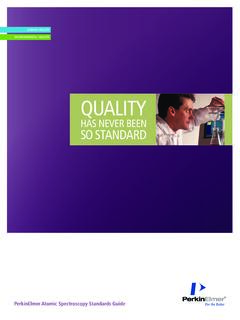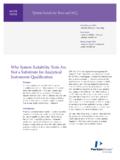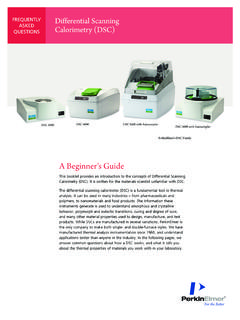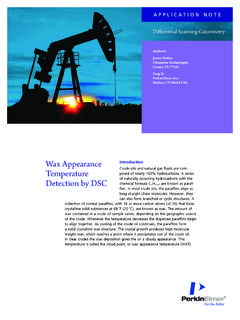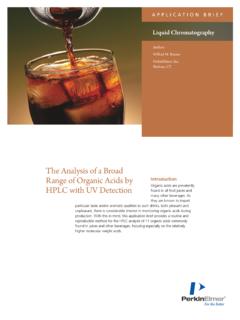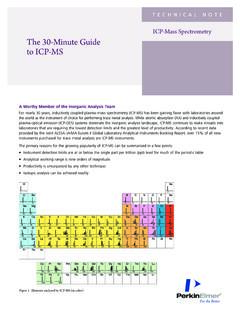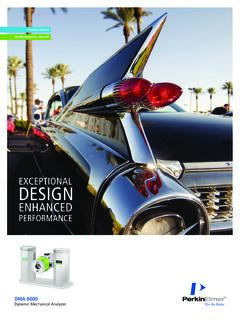Transcription of DSC as Problem Solving Tool: Measurement of Percent ...
1 DSC as Problem Solving tool : Measurementof Percent crystallinity of Sichina, International Marketing ManagerIntroductionOne of the most importantproperties of semi-crystallinethermoplastics (including PET,nylon, polyethylene, polypropylene,fluoro polymers, PES, PEEK) is thepolymer s Percent crystallinity . Thisrefers to the overall level ofcrystalline component inrelationship to its amorphouscomponent. The percentcrystallinity is directly related tomany of the key properties exhibitedby a semi-crystalline polymerincluding: Brittleness Toughness Stiffness or modulus Optical clarity Creep or cold flow Barrier resistance (ability toprevent gas transfer in or out) Long term stabilityApplications where knowing thevalue of the Percent crystallinity arecritical include.
2 Injection molded parts andcomponents Plastic food and beveragecontainers Fibers Films Automotive componentsThe assessment of a polymer spercent crystallinity can be mosteasily performed using differentialscanning calorimetry (DSC) whichmeasures the heat flow into or froma sample as it is either heated,cooled or under Pyris 6 DSC fromPerkinElmer provides an idealmeans of measuring the percentcrystallinity of thermoplasticmaterials. The instrument offers thefollowing important features: High performance in terms ofsensitivity and resolution Low cost Outstanding, reliableautosampler for automatedloading of up to 45 samples forunattended operation Highly stable performance forconsistent and reproducibleresults Pyris software (Windows NT-based) for ease of use Pyris Player for single button,start-to-finsh operationPerkinElmer also has availablespecial software, TemperatureDependent crystallinity software,which provides an enhanced and moreconvenient means of measuringpercent crystallinities noteFigure 1.
3 DSC results on as-received PET plastic food Instruments761 Main AvenueNorwalk, CT 06859-0010 USATel: 80O-762-4000 or(1+) 203-762-4000 Fax: (1+) 203-762-4228 Visit our website at Analysis 2000 perkinelmer , Inc. Printed in of PercentCrystallinityAs an example of the practicalimportance of knowing the percentcrystallinity of polymers, a majorfood company recently hadproblems with their plastic ketchupbottles. Some consumers noted thatthe ketchup bottles containedsignificantly less ketchup thanspecified on the label. The stateauthorities were notified and theyverified that the ketchup was not upto specified levels.
4 The ketchupbottles from this particular foodcompany were removed from thestore shelves and the company wasfined. It was later found that theplastic bottles were defective (due toa greater concentration of recyclatesin the plastic) and were lesscrystalline that they should havebeen. The lower crystallinity of thebottle permitted the water in theketchup to seep through to theoutside (poor barrier resistance) andthis led to the decrease in the weightof the ketchup inside the of the plastic bottles withDSC would have shown that thebottles were defective with lowerthan desired Percent perform this importantpercent crystallinity Measurement ,approximately 10 mg of the sampleis cut from the test specimen andaccurately weighed.
5 The followingtest conditions are used to measurethe sample s crystallinity :Initialtemperature:Room temperatureFinaltemperature:30 C above meltingtemperature ofpolymerHeating rate:10 C/minPurge gas:Approximately 10mgSample pan:Crimped aluminumpanThe heats of melting, Hm, andcold crystallization, Hc, aredetermined by integrating the areas(J/g) under the peaks. Dependingupon the sample s given thermalhistory, a cold crystallizationexothermic peak may or may not beobserved during the Percent crystallinity is thendetermined using the followingequation:% crystallinity = [ Hm Hc] / Hm 100%In this equation, the heats ofmelting and cold crystallization arein terms of J/g.
6 The term Hm is areference value and represents theheat of melting if the polymer were100% crystalline. This referenceheat of melting has been establishedfor each of the commonly usedpolymers and some of these arelisted belowPolymer Hm (J/g)Nylon 6, perkinelmer TemperatureDependent crystallinity softwaredirectly provides these values tomake the assessment of the percentcrystallinity more convenient crystallinity Results fromPET ContainerPolyethylene terephthalate (PET) iswidely utilized for the production of foodand beverage containers. PET bottleresins provide good impact resistance,good optical clarity and barrier resistance,provided that the resin achieves a properpercent crystallinity during containers are manufactured using ablow molding process where the resin ismelted, injected into a mold were the resinassumes the temporary shape of a air is then introduced into thetube, which then expands the shape of thecontainer to its final form.
7 As this occurs,the resin acquires a certain level ofcrystallinity which then affects the finalproperties of the container includingoptical clarity, gas permeability, impactresistance, stiffness, resistance to creep, in Figure 1 are the DSCresults, generated on the PerkinElmerPyris 6 DSC instrument, for an as-received PET as-received bottle resin showsthree distinct transitions, all of whichare key to the properties exhibited bythe container:Tg or glass transition at 75 Cwhere the resin undergoes softeningCold crystallization at 101 C ( Hc= J/g) where the polymerundergoes some small amount ofcrystallization while heating in theDSCM elting at 247 C ( Hm = J/g)where the existing crystallinecomponent is destroyedThe Percent crystallinity of thisparticular PET food container can beassessed based on these DSC resultsand based on the theoretical heat ofmelting for 100% crystalline PET: perkinelmer Instruments761 Main AvenueNorwalk, CT 06859-0010 USATel: 80O-762-4000 or(1+) 203-762-4000 Fax.
8 (1+) 203-762-4228 Visit our website at Analysis 2000 perkinelmer , Inc. Printed in crystallinity = ( ) 100%% crystallinity = this value is critical fora food container as, if the value istoo low, the barrier resistance willbe low and its creep propensity willbe high. Similarly, if the percentcrystallinity is too high, thecontainer may suffer with regards toits impact and optical order to enhance the propertiesof the PET resin for certain packagingapplications, the blow molded bottlemay be held at an elevatedtemperature between Tg and Tm tostabilize the properties of the resin andto produce an increase in thecontainer s Tg.
9 This will allow thecontainer to be used for more criticalbarrier resistance uses, such as storageof orange juice, milk and beer. ThePET container resin was annealed for3 minutes at 180 C in order to producechanges in the structure ormorphology of the resin and the DSCresults for the annealed resin aredisplayed in Figure Tg or softening temperatureincreased by about 20 C to 93 C,which is important for better storageof gas sensitive liquids such as orangejuice or beerThe cold crystallization peakdisappears entirelyA heat set, pre-meltingendothermic peak is observed at 188C which reflects the annealingprocessing stepThe overall level of crystallinity ofthe PET container resin issignificantly increasedThe Percent crystallinity of theannealed container resin is calculatedas:% crystallinity = / 100%% crystallinity = results demonstrate that thebrief annealing step produces a muchhigher Tg (75 versus 93 C) and ahigher crystallinity ( ) for the PET food 2.
10 DSC results from PET container resin after being annealed at 180 Cfor 3 3. DSC results on quench cooled PET container Instruments761 Main AvenueNorwalk, CT 06859-0010 USATel: 80O-762-4000 or(1+) 203-762-4000 Fax: (1+) 203-762-4228 Visit our website at Analysis 2000 perkinelmer , Inc. Printed in great sensitivity to PET resinto its given processing conditionsmay also be demonstrated by quenchcooling the resin from the melt, asshown by the DSC results in quench cooled PET resin hasan extremely low crystalline contentand is nearly entirely cooling rapidly from the melt,the PET resin does not have time todevelop a significant crystallinecomponent.
